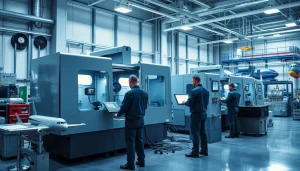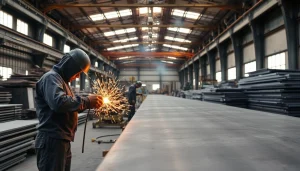Essential Guide to Laminating Resin: Techniques, Applications, and Best Practices

Understanding Laminating Resin
What is Laminating Resin?
Laminating resin is a specialized polymer system used to bind together layers of materials, primarily in composite applications. It serves as a crucial component in the fabrication of a variety of products, ranging from boats and sports equipment to automotive parts and industrial tooling. This resin provides structural integrity and enhances the overall strength of the laminated structure. What sets laminating resin apart is its unique curing properties, enabling it to solidify and create a firm bond even under challenging conditions.
Types of Laminating Resin
There are primarily two categories of laminating resins: polyester and epoxy. Understanding their differences is essential for selecting the right type for your project.
- Polyester Laminating Resin: This type is popular for its cost-effectiveness and ease of use. It is often employed in marine applications due to its resistance to water and ability to bond well with fiberglass. Polyester laminating resin offers a faster cure time, making it ideal for projects requiring quick turnaround.
- Epoxy Laminating Resin: Epoxy is renowned for its superior strength and adhesion properties. It works exceptionally well in applications demanding high durability and can be used with various substrates beyond fiberglass, like wood and metal. Although generally more expensive than polyester, epoxy laminating resin often justifies the cost with its enhanced performance and longevity.
Benefits and Uses of Laminating Resin
Laminating resins offer a myriad of benefits that make them the go-to solution for many composite applications:
- High Strength-to-Weight Ratio: Laminating resin creates lightweight yet strong structures, an essential trait for industries like aerospace and automotive.
- Versatility: These resins can be formulated for various applications, including waterproofing, heat resistance, chemical resistance, and UV stability.
- Easy Application: Laminating resins are typically easy to mix and apply, requiring minimal tools or setup, making them accessible for both professionals and DIY enthusiasts.
- Customizability: With the ability to add various fillers, colorants, and additives, users can customize the properties of laminating resins to meet specific project requirements.
Application Techniques for Laminating Resin
Preparation of Materials
Before applying laminating resin, proper preparation of both the workspace and materials is crucial. The surface to be laminated should be clean, dry, and free of contaminants such as oils, dust, or old coatings. For robustness, it is often recommended to lightly sand the surface to enhance adhesion. Protective gear, including gloves and goggles, should be worn to ensure safety during handling. Additionally, ensure the working environment is well-ventilated to mitigate inhalation of fumes.
Mixing Laminating Resin
Once the materials are prepped, the next step is accurate mixing of the laminating resin. For both polyester and epoxy systems, follow the manufacturer’s instructions carefully for mixing ratios, usually specified in volume or weight. Inaccurate mixing can lead to improper curing, affecting the final properties of the laminate.
For epoxy resins, the mixing process often involves combining the resin with a hardener. Stir thoroughly, ensuring that no lumps remain and that the mixture is uniform. For polyester resins, a catalyst (usually MEKP) is added to initiate the curing process. Make sure to mix well without introducing air bubbles, as they can compromise the laminate’s integrity.
Pouring and Curing Process
After mixing, the laminating resin can be applied using brushes, rollers, or by pouring directly onto the surface. If using fiberglass cloth, it’s best to use a wet lay-up technique, wherein the resin is applied to the fabric as it is laid down, ensuring complete saturation.
Curing time varies significantly between different types of laminating resin and is affected by factors like temperature and humidity. It is essential to maintain the recommended curing conditions as indicated by the manufacturer. Improper curing can result in structural failures, so vigilance is key during this stage.
Choosing the Right Laminating Resin for Your Project
Factors to Consider
The choice of laminating resin is influenced by various aspects:
- Application Requirements: Is the application exposed to high temperatures, moisture, or chemicals? Make sure to select a resin that matches such conditions.
- Working Time: Different formulations have varied pot lives. If you’re working on large projects, consider a resin with a longer working time.
- Finish Type: Some applications require a smooth finish, while others can be rough. The choice of resin can affect the final texture.
- Budget: Cost is often a deciding factor. Assess the benefits each resin type provides versus its cost to determine the best option.
Comparing Different Laminating Resin Options
When selecting a laminating resin, consider the trade-offs between polyester and epoxy options. Polyester resins are generally less expensive and cure faster, making them suitable for less demanding applications. However, for applications requiring higher strength and durability, epoxy laminating resins might be the preferred choice despite their higher cost.
Common Use Cases
Laminating resin is widely utilized in various sectors. Here are some examples of common applications:
- Marine: Lamination of boats and canoes, where water resistance and strength are critical.
- Aerospace: Manufacturing light-weight, durable components for aircraft.
- Automotive: Parts such as panels and structural components benefitting from enhanced strength and weight reduction.
- Sports Equipment: Manufacturing items such as surfboards, bicycles, and athletic gear.
Challenges and Solutions in Working with Laminating Resin
Dealing with Bubbles and Inclusions
Air bubbles are a common issue encountered during the application of laminating resin. To reduce their occurrence, it is advisable to mix the resin slowly and avoid vigorous stirring. Furthermore, using a vacuum chamber during the mixing process can eliminate air trapped in the resin. If bubbles are noted after application, using a heat gun can help to release trapped air by warming the resin and allowing the bubbles to rise to the surface.
Temperature and Curing Issues
Temperature significantly influences the curing process of laminating resin. Cold conditions can slow down curing times or lead to improper curing. Conversely, high temperatures can accelerate curing, leading to issues such as brittleness. It is recommended to work within the temperature range specified by the resin manufacturer. For regions with fluctuating temperatures, consider using a controlled heating method to maintain optimal conditions.
Repair Techniques for Laminated Surfaces
Should defects occur, repair techniques will vary depending on the nature of the damage. Minor scratches and surface imperfections can often be addressed with additional layers of resin or a light sanding followed by polishing. For more significant repairs, it might be necessary to cut out the damaged area, layer fibers and replacement resin, and cautiously follow the original lamination process to ensure a seamless repair.
Advanced Techniques in Laminating Resin Use
Integrating Laminating Resin with Other Materials
For specialized applications, laminating resins can be effectively integrated with various materials including fabrics, metals, and woods. This integration enhances the overall mechanical properties of the final composite product. For instance, combining glass fibers with epoxy laminating resin results in a composite that offers excellent tensile strength, making it suitable for high-stress applications.
Innovative Laminating Resin Applications
Ongoing research and advancements in resin formulations are leading to innovative applications. For example, incorporating nanomaterials can enhance the thermal and structural properties of the laminating resin, making it applicable in cutting-edge fields such as aerospace composites and high-performance automotive components.
Performance Metrics and Testing
Testing the performance of laminated structures is crucial for validating their effectiveness and durability. Metrics such as tensile strength, flexural strength, and impact resistance should be carefully evaluated. Many professionals employ standardized tests established by relevant industry organizations to ensure compliance and functionality.
Ultimately, understanding the nuances of laminating resin application processes and selection criteria will empower you to achieve optimal results in your projects. With a solid grasp of the materials and techniques at your disposal, you are well-equipped to tackle any composite fabrication endeavor confidently.






